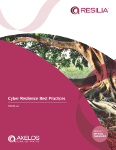In this Help Net Security interview, Charles Brooks, Adjunct Professor at Georgetown University’s Applied Intelligence Program and graduate Cybersecurity Programs, talks about how zero trust principles, identity access management, and managed security services are crucial for effective cybersecurity, and how implementation of new technologies like AI, machine learning, and tracking tools can enhance supply chain security.
CISOs believe they have adequate data protection measures, yet many have dealt with the loss of sensitive data over the past year. How do you reconcile this apparent contradiction?
The loss of data despite protection measures is not that surprising. We are all playing catchup in cybersecurity. The internet was invented in a government laboratory and later commercialized in the private sector. The hardware, software, and networks were originally designed for open communication. Cybersecurity initially was not a major consideration. That mindset has surely changed due to the explosion of connectivity and commerce on the internet and CISOs are playing a big game of catch up too.
There are a multitude of causes that can account for the exfiltration of sensitive data. The first being that hacker adversaries have become more sophisticated and capable of breaching. The basic tools and tactics hackers use for exploitation include malware, social engineering, phishing (the easiest most common, especially spear-phishing aimed at corporate executives), ransomware, insider threats, and DDOS attacks. Also, they often use advanced and automated hacking tools shared on the dark web, including AI and ML tools that are used to attack and explore victims’ networks. That evolving chest of hacker weaponry is not so easy for CISOs to defend against.
Another big factor is the reality is that exponential digital connectivity propelled by the COVID-19 pandemic has changed the security paradigm. Many employees now work from hybrid and remote offices. There is more attack surface area to protect with less visibility and controls in place for the CISO. Therefore, it is logical to conclude that more sensitive data has and will be exposed to hackers.
The notion of adequate protection is a misnomer as threats are constantly morphing. All it takes is one crafty phish, a misconfiguration, or a failure to do a timely patch for a gap to provide an opportunity for a breach. Finally, many CISOs have had to operate with limited budgets and qualified cyber personnel. Perhaps they have lower expectations of the level of security they can achieve under the circumstances.
As the economic downturn pressures security budgets, how can CISOs optimize their resources to manage cybersecurity risks effectively?
CISOs must enact a prudent risk management strategy according to their industry and size that they can follow to allow them to best optimize resources. A good risk management strategy will devise a vulnerability framework that Identifies digital assets and data to be protected. A risk assessment can quickly identify and prioritize cyber vulnerabilities so that you can immediately deploy solutions to protect critical assets from malicious cyber actors while immediately improving overall operational cybersecurity. This includes protecting and backing up business enterprise systems such as: financial systems, email exchange servers, HR, and procurement systems with new security tools (encryption, threat intel & detection, firewalls, etc.) and policies.
There are measures in a vulnerability framework that are not cost prohibitive. Those measures can include mandating strong passwords for employees and requiring multi-factor authentication. Firewalls can be set up and CISOs can make plans to segment their most sensitive data. Encryption software can also be affordable. The use of the cloud and hybrid clouds enables implementation of dynamic policies, faster encryption, drives down costs, and provides more transparency for access control (reducing insider threats). A good cloud provider can provide some of those security controls for a reasonable cost. Clouds are not inherently risky, but CISOs and companies will need to recognize that they must thoroughly evaluate provider policies and capabilities to protect their vital data.
And if a CISO is responsible for protecting a small or medium business without a deep IT and cybersecurity team below them, and are wary of cloud costs and management, they can also consider outside managed security services.
How can organizations better safeguard their sensitive information during high employee turnover?
This goes to the essence of the strategy of zero trust. Zero trust (ZT) is the term for an evolving set of cybersecurity paradigms that move defenses from static, network-based perimeters to focus on users, assets, and resources. Organizations need to know everything that is connected to the network, devices & people.
Identity access management or IAM, is very important. IAM the label used for the set of technologies and policies that control who accesses what resources inside a system. A CISO must determine and know who has access to what data and why. If an employee leaves, they need to immediately revoke privileges and ensure that nothing sensitive was removed from the organization. There are many good IAM tools available from vendors on the market.
Certainly, with employee turnover, there are ethical and trust elements involved. Employee insider threats are difficult to detect and manage. Some of that can be addressed upfront in employment contracts with an employee understanding of the legal parameters involved, it is less likely that they will run off with sensitive data.
We’ve seen increased CISO burnout and concerns about personal liability.
Yes, the burnout is a direct result of CISOs having too many responsibilities, too little budget, and too few workers to run operations and help mitigate growing cyber-threats. Now the personal liability factors exemplified by as the class action suit against Solar’s Wind’s CISO, and the suit against Uber’s CISO for obscuring ransomware payments, has heightened the risk. In an industry that is already lacking in required numbers of cybersecurity leaders and technicians, CISOs need to be given not only the tools, but the protections necessary for them to excel in their roles. If not, the burnout and liability issues will put more companies and organizations at greater risk.
How are these challenges impacting the overall efficacy of CISOs in their roles, and what measures can be taken to address them?
Despite the trends of greater frequency, sophistication, lethality, and liabilities associated with incursions, industry management has been mostly unprepared and slow to act at becoming more cyber secure. A Gartner survey found that 88% of Boards of Directors (BoDs) view cybersecurity as a business risk, as opposed to a technology risk, according to a new survey, and that only 12% of BoDs have a dedicated board-level cybersecurity committee.
“It’s time for executives outside of IT to take responsibility for securing the enterprise,” said Paul Proctor, Chief of Research for Risk and Security. “The influx of ransomware and supply chain attacks seen throughout 2021, many of which targeted operation- and mission-critical environments, should be a wake-up call that security is a business issue, and not just another problem for IT to solve.”
CISOs not only need a seat at the table in the C-Suite, but they also need insurance protections comparable to other executive management that limits their personal liability. There is no panacea for perfect cybersecurity. Breaches can happen to any company or person in our precarious digital landscape. It is not fair or good business to have CISO go at it alone. In a similar context, cybersecurity should no longer be viewed as a cost item for businesses or organizations. It has become an ROI that can ensure continuity of operations and protect reputation. Investment in both the company and the CISO’s compensation and portfolio of required duties need to be a priority going forward.
As supply chain risk continues to be a recurring priority, how can CISOs better manage this aspect of their cybersecurity strategies, especially under constrained budgets?
Ensuring that the supply chain is not breached including the design, manufacturing, production, distribution, installation, operation, and maintenance elements is a challenge to all companies. Cyber-attackers will always look for the weakest point of entry and mitigating third-party risk is critical for cybersecurity. Supply chain cyber-attacks can be perpetrated from nation-state adversaries, espionage operators, criminals, or hacktivists.
CISOs require visibility of all vendors in the supply chain along with set policies and monitoring. NIST, a non-regulatory agency of the US Department of Commerce has a suggested framework for supply chain security that provides sound guidelines from both government and industry.
NIST recommends:
- Identify, establish, and assess cyber supply chain risk management processes and gain stakeholder agreement
- Identify, prioritize, and assess suppliers and third-party supplier partners
- Develop contracts with suppliers and third-party partners to address your organization’s supply chain risk management goals
- Routinely assess suppliers and third-party partners using audits, test results, and other forms of evaluation
- Complete testing to ensure suppliers and third-party providers are able to respond to and recover from service disruption
Other mitigation efforts can be done with the acquisition of new technologies that monitor, alert, and analyze activities in the supply chain. Artificial intelligence and machine learning tools can provide visibility and predictive analytics, and stenographic and watermark technologies can provide tracking of products and software.

Previous DISC InfoSec posts on CISO topic

InfoSec tools | InfoSec services | InfoSec books



























![Reblog this post [with Zemanta]](https://img.zemanta.com/reblog_e.png?x-id=b25c3a4a-2ebf-489a-832b-b3841efa99c9)


